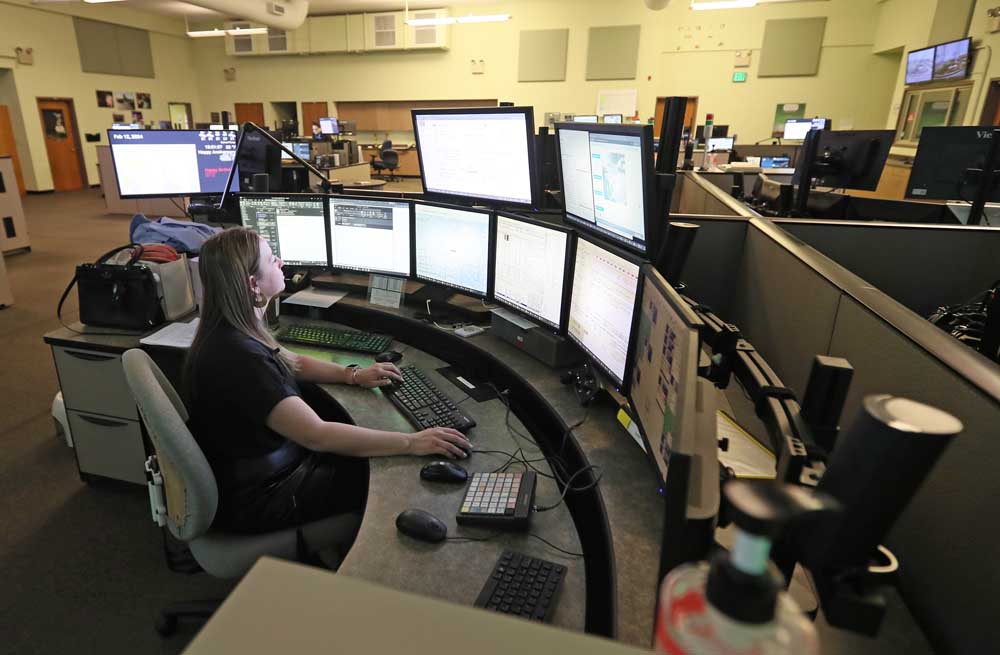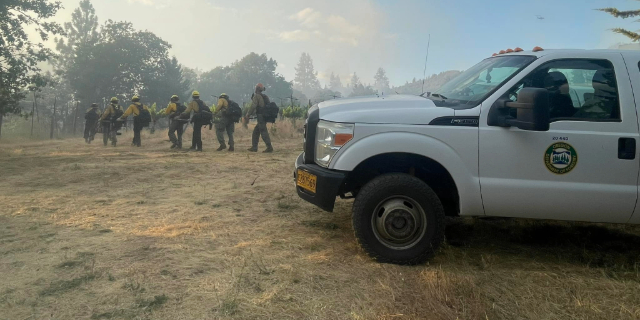Emergency radio system has $4.6-million shortfall for regional upgrade
Published 4:15 pm Tuesday, February 13, 2024

- Sarah Leonard, Emergency Communications of Southern Oregon 911 dispatch manager, takes a call Monday at the dispatch facility in Medford.
A $4.6-million shortfall could impact a much-needed regional upgrade to emergency radio systems operated by Emergency Communications of Southern Oregon.
ECSO officials spent recent weeks rallying support from local municipalities and fire and police service providers. They hope state leaders approve a request for financial help during the legislative short session that began Monday.
Funded through a voter-approved $28-million bond in 2019, the project will add 20 radio tower sites and upgrade eight existing sites to eliminate dead zones and achieve 95% radio coverage throughout Jackson County. The new system would replace outdated analog gear with state-of-the-art digital communications equipment.
Construction has been underway since last summer, with ECSO officials racing against the clock: In order for bond funds to be spent by the March 2026 deadline, construction must be completed before the end of 2024 to allow enough time for the switchover.
Tim Doney, ECSO 911 director, said ECSO officials have collected letters of support from state representatives, first responder agencies and governing bodies around the region to urge state officials to help make up the shortfall.
He said the project is expected to come in at 16% over budget due to inflation and rising material and labor costs in the construction industry, as well as increased costs for land leases, liability insurance and project management.
“We started construction on all the radio sites, most of which are on mountain tops around the county, this past summer. We’ve run into a variety of issues causing either time delays or substantial cost increases,” Doney said Monday, noting that the remoteness of some sites requires roads or other infrastructure to be built for access.
“What’s really killed us (are) the inflationary costs, and that the costs of doing construction have really been skyrocketing. It’s one of those projects where we’ve cut corners in places that we’re able to do so without sacrificing radio coverage, but it’s still not enough.”
Replacement of the antiquated system has been a focus since ECSO formed through a 2010 merger between the city of Medford’s dispatch service and Southern Oregon Regional Communications.
A study was conducted in 2013 and 2014 that determined most of the public radio infrastructure — not the 911 system itself, but the part of the system emergency responders use to communicate via radio with one another and with dispatch — is 1990s technology, Doney said.
If state leaders don’t help with the funding shortfall, Doney said a combination of increased fees to partner agencies and cuts to expansion plans — which could result in reduced radio coverage — would be considered.
The system must be replaced regardless, Doney said.
“We’re operating with a very, very old system, and we often have to search high and low to find parts to fix it,” he added.
The new radio system, he said, “will really increase our ability to converse with first responders in a lot of places in the county where we don’t currently have communication connections with our first responders.”
Doney said the dead zones include rural, outlying areas but also some urban areas, including a space between Ashland and Phoenix where first responders rely on cell phone service for backup communication when radio signals fail.
The new system would also help in more densely constructed buildings, such as concrete structures, where radio signals often won’t transmit. Adding to the cost, ECSO must execute the infrastructure expansion project while keeping the old system operational.
State Rep. Pam Marsh, D-Ashland, is championing the request for the additional funds.
“We live in a community with high risks of wildfire and other natural disasters, and it is critical that we get our emergency communications system fully updated and modernized in order to keep Southern Oregon as safe as possible,” Marsh said in an email to the Rogue Valley Times.
“Our community stepped up in 2019 when Jackson County voters agreed to pay for $28 million in bonding for this project, but increasing project costs mean that we now need another $4.5 million to complete the communication system build-out,” Marsh continued. “This will be a challenging funding request given the short session, but we are doing everything possible to demonstrate that this funding is vital.”






